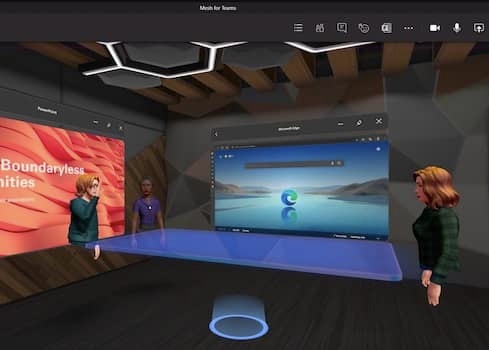The metaverse has arrived. Here's what CIOs need to know about it -- from business use cases, to risks, to vendor offerings from companies such as Microsoft, Nvidia, and Facebook.

The “metaverse” is coming. Are you ready? Microsoft, Nvidia, and Facebook have all announced significant applications to give enterprises a door into the metaverse. Many startups are also building this kind of technology.
But just what is the metaverse anyway? Is it something that CIOs need to have on their radar? What are the use cases for businesses? And what are the caveats that organizations need to watch for to reduce risk?
What Is a Metaverse?
Metaverse is essentially a 3D mixed reality “place” that combines the real world/physical world with the digital world. It is persistent, meaning it continues to exist even if you close the app or logout. It is also collaborative, meaning that people in that world see the same thing and can work together. Some experts say that the metaverse will be a new 3D layer of the internet. Gartner’s definition goes one step further, says Tuong Nguyen, senior research analyst at Gartner, specifying that a true metaverse must be interoperable with other metaverses (and thus, many of today’s iterations don’t fit the Gartner definition yet.)
Here’s how Nvidia CEP Jensen Huang put it during his keynote address at Nvidia GTC 2021 online event this month: “The internet is essentially a digital overlay on the world. The overlay is largely 2D information -- text voice, images, video -- but that’s about to change. We now have the technology to create new 3D virtual worlds or model our physical world."
Today’s video conferencing, driven into the mainstream by the pandemic, is an example of two-dimensional collaboration. People can participate via their laptop cameras and microphones from home, or they can be in the office in a teleconference room. They can share their screens or use apps that allow for a collaborative whiteboard.
A metaverse layers immersive 3D on top of that. Participants can create avatars (digital representations of themselves) and use those to enter a virtual 3D room. In that room they can collaborate on a virtual whiteboard on the virtual wall or walk around a virtual 3D model of a car they are designing, for instance.
That’s essentially the use case that Microsoft CEO Satya Nadella described when he announced Mesh for Microsoft Teams at the tech giant’s Ignite conference this month. Microsoft will add this capability to its Teams collaboration tool starting in 2022.
This feature combines the capabilities of Microsoft’s mixed-reality platform Mesh (announced in March 2021 as a platform for building metaverses) with the productivity tools of Microsoft Teams, according to Microsoft.
Facebook, which rebranded itself as Meta earlier this year, introduced Horizon Workrooms in August, which are VR meeting spaces for remote collaboration.
Metaverse Use Cases for the Enterprise
Collaboration is one of three primary use cases for a metaverse in the enterprise right now, according to Forrester VP J.P. Gownder.
Another primary use case is one championed by chip giant Nvidia -- simulations and digital twins. Huang announced Nvidia Omniverse Enterprise during his keynote address at the company’s GTC 2021 online AI conference this month and offered several use cases that focused on simulations and digital twins in industrial settings such as warehouses, plants, and factories.
If you are an organization in an industry with expensive assets -- for instance oil and gas, manufacturing, or logistics -- it makes sense to have this use case on your radar, according to Gartner’s Nguyen. “That’s where augmented reality is benefiting enterprise right now,” he says.
As an example, during his keynote address, Nvidia’s Huang showed a video of a virtual warehouse created with Nvidia Omniverse Enterprise enabling an organization to visualize the impact of optimized routing in an automated order picking scenario. That’s an example of a particular use case, but Omniverse itself is Nvidia’s platform to enable organizations to create their own simulations or virtual worlds.
“We built Omniverse for builders of these virtual worlds,” Huang said at GTC. “Some worlds will be for gatherings and games. But a great many will be built by scientists, creators, and companies. Virtual worlds will crop up like websites today.”
The third use case for enterprises falls in the business-to-consumer marketing realm as demonstrated by online gaming platform company Roblox, according to Gownder. On this gaming platform that’s popular with the pre-teen crowd, users can purchase digital clothing to outfit their avatars, and brands are taking notice. For instance, apparel brands including Vans and Gucci have created customized, branded worlds on Roblox.
Should CIOs Put Metaverse on Their Tech Roadmaps?
Yes, but no need to jump in with both feet yet, the experts say.
“CIOs should be thinking about these examples,” says Nguyen. “But you don’t need to have a metaverse presence.” Yet. “It would behoove you to get that frame of reference because of the inevitability. Not being a part of this in some way, you will likely be missing out substantially, just like any organization that doesn’t have a website today.”
Indeed, it may pay off if you decide to wait for version 2. Microsoft’s Mesh for Teams lets users create an avatar and use that instead of turning on their webcams. These personal avatars come complete with facial expressions to convey reactions.
“This is unlikely to get the same level of engagement for others utilizing video in a meeting,” says Tim Banting, Omdia’s practice leader for the Digital Workplace. “Consequently, Omdia believes this feature to be somewhat of a gimmick.”
However, some other use cases may appeal to organizations, he adds. Yet there are other caveats for enterprises to consider when it comes to practical implementation.
“A specific headset, rather than a PC or mobile device, would be required to maximize the user experience,” Banting says. “With many organizations failing to offer remote staff business-quality headsets and external webcams, it’s unlikely that enterprises could justify the expense of VR equipment for regular employee meetings.”
Do You Need to Skill Up Your IT Workforce?
Many of the benefits of metaverse technology will be available through your existing technology vendors already, like Mesh for Microsoft Teams. What’s more, Banting points out that in the consumer VR world, “it’s very much a plug and play environment with easy setup.”
However, “Where things could get interesting is when businesses want to create their own ‘branded’ metaverse. I expect this will be an advanced services opportunity for a new category of partners working in conjunction with marketing.”
Gownder said that an understanding of 3D is a rare skill today, so finding people who can develop on Unity or Unreal Engine may be valuable. But it’s not something that everyone will need to jump on right away.
What Are the Risks?
Consider the internet. When those first websites appeared in the 1990s, there was no way to know what lay ahead.
“Thirty years ago, who would have thought we’d be here today with trolls, disinformation, hacking, and more,” says Nguyen. “The downsides we talk about will all be couched in what we understand today such as security, privacy, and ethics.”
What to Read Next:
About the Author(s)
You May Also Like







